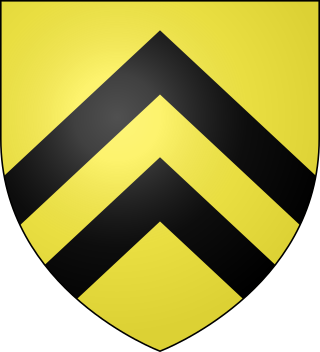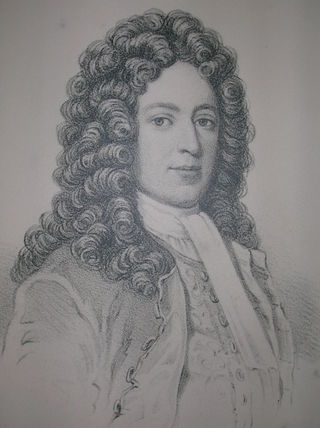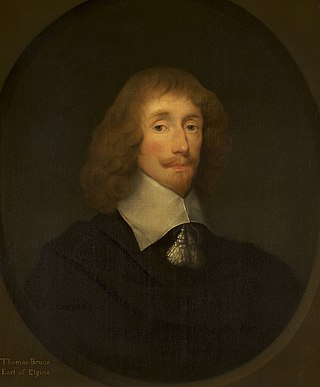Related Research Articles

Earl of Pembroke is a title in the Peerage of England that was first created in the 12th century by King Stephen of England. The title, which is associated with Pembroke, Pembrokeshire in West Wales, has been recreated ten times from its original inception. Due to the number of creations of the Earldom, the original seat of Pembroke Castle is no longer attached to the title.

Earl of Derby is a title in the Peerage of England. The title was first adopted by Robert de Ferrers, 1st Earl of Derby, under a creation of 1139. It continued with the Ferrers family until the 6th Earl forfeited his property toward the end of the reign of Henry III and died in 1279. Most of the Ferrers property and the Derby title were then held by the family of Henry III. The title merged in the Crown upon Henry IV's accession to the throne in 1399.
Adam Loftus, 1st Viscount Loftus, was Lord Chancellor of Ireland from 1619 and from 1622 raised to the peerage of Ireland as Viscount Loftus of Ely, King's County. His uncle, another Adam Loftus, was both Lord Chancellor of Ireland and Church of Ireland primate.

Lord Kirkcudbright was a title in the Peerage of Scotland. It was created for Sir Robert Maclellan of Bombie on a 1633 royal visit to Scotland by King Charles I of England. Maclellan had already been created a baronet of Nova Scotia in 1631.

Alexander Seton Montgomerie, 9th Earl of Eglinton was a Scottish peer, lord of the Eglinton Estate.
Sir Thomas Maclellan was Provost of Kirkcudbright and father of Robert Maclellan, 1st Lord Kirkcudbright. He was responsible for the construction of MacLellan's Castle in the town.

The Clan MacLellan is a Scottish clan of the Scottish Lowlands. The clan does not currently have a chief therefore it is considered an Armigerous clan.

Thomas Dillon, 4th Viscount DillonPC (Ire) (1615–1673) held his title for 42 years that saw Strafford's administration, the Irish Rebellion of 1641, the Irish Confederate Wars and the Cromwellian Conquest of Ireland. He was a royalist and supported Strafford and Ormond. He sided with the Confederates for a while but was a moderate who opposed Rinuccini, the papal nuncio.
MacLellan, McLellan, or variants thereof, is a surname of Scottish origin, some of whom emigrated to Ireland. The name is an Anglicisation of the Scottish Gaelic Mac Gille Fhaolain, and the Irish Gaelic Mac Giolla Fhaoláin, which meant "son of the servant of (Saint) Faolán". The personal name, Faolán, is thought to be a diminutive of faol, meaning "wolf" or "little wolf".

Francis Annesley, 1st Viscount Valentia, was an English statesman during the colonisation of Ireland in the seventeenth century. He was a Member of Parliament for both the English and Irish houses, was elevated to the Irish peerage as Baron Mountnorris, and later gain the additional title Viscount Valentia. He is best remembered for his clash with the Lord Lieutenant, Thomas Wentworth, who in order to render Annesley powerless had him sentenced to death on a spurious charge of mutiny, although it was clearly understood that the sentence would not be carried out.
Sir William Parsons, 1st Baronet of Bellamont, PC (Ire), was known as a "land-hunter" expropriating land from owners whose titles were deemed defective. He also served as Surveyor General of Ireland and was an undertaker in several plantations. He governed Ireland as joint Lord Justice of Ireland from February 1640 to April 1643 during the Irish rebellion of 1641 and the beginning of the Irish Confederate War.
James Livingstone, 1st Viscount Kilsyth, was a devoted Scottish Royalist who was raised to the peerage of Scotland as Viscount Kilsyth and Lord Campsie in 1661.
Sir Laurence Esmonde, 1st Baron Esmonde (1570?–1646), was an Irish peer who held office as governor of the fort of Duncannon in County Wexford. He was a leading Irish Royalist commander in the English Civil War, but was later suspected of disloyalty to the English Crown when he surrendered Duncannon Fort to the enemy. He was the ancestor of the Esmonde Baronets, although the barony died with him.
Nicholas St. Lawrence, 9th Baron Howth (c.1550–1607) was a leading member of the Anglo-Irish nobility in the late sixteenth and early seventeenth centuries. Despite openly professing his Roman Catholic faith, he enjoyed the trust of Elizabeth I and of successive Lord Deputies of Ireland, and was even forgiven by the English Crown for signing a petition protesting against the enforcement of the Penal Laws.

Thomas Bruce, 1st Earl of Elgin, 3rd Lord Bruce of Kinloss, of Houghton House in the parish of Maulden in Bedfordshire, was a Scottish nobleman.
Sir Robert Travers was an Irish judge, soldier and politician of the early seventeenth century. Despite his unenviable reputation for corruption, he had a highly successful career until the outbreak of the Wars of the Three Kingdoms, when he went into opposition to King Charles I. He fought on the side of the Irish Parliament, and was killed at the Battle of Knocknanuss. He was a nephew of the poet Edmund Spenser, and was the founder of a notable military dynasty.
Carey or Cary Dillon, 5th Earl of Roscommon, PC (Ire) (1627–1689) was an Irish nobleman and professional soldier of the seventeenth century. He held several court offices under King Charles II and his successor King James II. After the Glorious Revolution he joined the Williamite opposition to James and was in consequence attainted as a traitor by James II's Irish Parliament in 1689. In that year he fought at the Siege of Carrickfergus shortly before his death in November of that year.
William Douglas, 1st Earl of Queensberry was a Scottish noble.
Sir Samuel McClellan, MacClellan or McLellan was a Scottish cloth merchant and politician who sat in the House of Commons of Great Britain from 1708 to 1709. He served as Lord Provost of Edinburgh from 1706 to 1708.
Robert Dillon, 2nd Earl of RoscommonPC (Ire) was styled Baron Dillon of Kilkenny-West from 1622 to 1641 and succeeded his father only a year before his own death. He supported Strafford, Lord Deputy of Ireland, who appointed him keeper of the great seal. Dillon was in December 1640 for a short while a lord justice of Ireland together with Sir William Parsons.
References
- Henderson, Thomas Finlayson (1893). . In Lee, Sidney (ed.). Dictionary of National Biography . Vol. 35. London: Smith, Elder & Co.